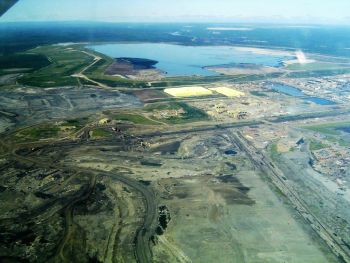Waste Management

|
| Syncrude Tailings Dam, Fort McMurray, Alberta
(Image Source: Wikipedia) |
Some dams are used to help manage or provide long-term storage of industrial waste materials. At mining facilities, these are referred to as tailings dams. Such structures can be designed to keep waste from seeping into or damaging the surrounding environment.
“Tailings are a by-product of mining, consisting of the processed rock or soil left over from the separation of the commodities of value from the rock or soil within which they occur. If they are not managed in a safe, responsible manner, tailings can pose risks to the environment, human health, and infrastructure. In cases where tailings are managed in purpose built (i.e., engineered) facilities, management of the integrity of these facilities is critically important”.[1]
“Most tailing facilities are planned, designed, constructed, operated, and closed in a safe and responsible manner. However, as recent failure incidents clearly indicate, the physical stability of tailings facilities has not been universal. Global performance needs to improve”.[1]
These type of dams are not inventoried fully, but after the failure of Brumadinho Dam(January 25, 2019) A foundation Global Tailings Portal has inventoried these type of dam. In the US , the Global Tailings Portal has inventoried 466 of these dams in the US.
Best Practices Resources
![]() Tailings Management: Good Practice Guide (International Council on Mining and Metals)
Tailings Management: Good Practice Guide (International Council on Mining and Metals)
![]() Global Industry Standard on Tailings Management (International Council on Mining and Metals)
Global Industry Standard on Tailings Management (International Council on Mining and Metals)
Citations:
Revision ID: 7817
Revision Date: 03/15/2024
